


ROBOTICS
ROBOTICS
Robotics is the art and commerce of robots, their design, manufacture, application, and practical use. Robots will soon be everywhere, in our home and at work. They will change the way we live. This will raise many philosophical, social, and political questions that will have to be answered. In science fiction, robots become so intelligent that they decide to take over the world because humans are deemed inferior. In real life, however, they might not choose to do that. Robots might follow rules such as Asimov’s Three Laws of Robotics, that will prevent them from doing so. When the Singularity happens, robots will be indistinguishable from human beings and some people may become Cyborgs: half man and half machine.

Robotlab
Manifest
Ein Roboter schreibt in einem autonomen Prozess Manifeste. Diese bestehen jeweils aus acht thesenartigen Sätzen, die vom Roboter eigenständig generiert werden. Dazu greift die Maschine auf einen festen Fundus von Begriffen aus den Themenbereichen Kunst, Philosophie und Technik zurück und assoziiert diese zufällig innerhalb von Satzstrukturen miteinander. Durch die Kombination von System und Zufall ist jedes geschaffene Manifest ein nummeriertes Unikat.

hanson robotics
Sophia the robot
Sofia, le robot humanoïde (android) ultra-réaliste fabriqué par Hanson Robotics, devient le premier robot a obtenir une citoyenneté officielle ! C’est l’Arabie Saoudite qui a officialisé il y a quelques jours l’existence de Sofia, devenant le premier pays à reconnaitre le statut de citoyen d’un robot et d’une intelligence artificielle. Sofia, dont nous avions déjà parlé l’année dernière, est un robot ultra-réaliste capable de tenir une conversation, de reconnaitre les gens et d’interagir avec son environnement, mais surtout possède sa propre personnalité et des expressions faciales réalistes.

T-HR3 Humanoid Robot
Toyota Motor Corporation
Toyota has revealed its third generation humanoid robot, the T-HR3, which can be controlled and synchronized with the operator’s movements. The user wears data gloves and an HTC Vive VR headset that’s linked to cameras to show the robot’s perspective. T-HR3 stands 1.54 meters tall and weighs 75kg ( 5 feet, 1 inches / 165 pounds) and was developed to explore the possibility of assisting humans in the home, medical facilities, construction sites, disaster areas, and even in space.more…


QUBIT AI: Paul Gründorfer & Leonhard Peschta
The Sea
FILE 2024 | Installations
International Electronic Language Festival
The Sea is an extraction of a complex natural phenomenon, resulting in an artificial emulation that develops a life form of its own. Just like the sea with its endless waves, this artificial system follows the impact of an immersive state, leading to a unique vision of an artificial generator. Despite appearing chaotic, it is capable of generating associations ranging from the movement of waves to science fiction scenarios.
Bio
Paul Gründorfer develops process-related systems and explores variable or unstable conditions in the occurrence of sound when exposed to amplification, feedback, and multiple signal streams. His works focus on processes that evolve in a social space. Leo Peschta is an artist and researcher. During his studies, he worked in various fields of media arts, including sound, installations and software, developing over the years a special interest in robotics and machinery.
Credits
Austrian Embassy

FILE 2024 – Call for Entries
The Call for Entries to participate in FILE – Electronic Language International Festival’s projects in 2024 is now open. The festival seeks original artworks in Art and Technology, by Brazilian and international artists. Registration remains open until February 10th. Access the registration form.
FILE is a non-profit cultural organization that has propagated creation and experimentation in Art and Technology through exhibitions, events and publications over 23 years. This call opens up the opportunity to participate in the 23rd. Edition of the Electronic Language International Festival, which is scheduled to take place at the FIESP Cultural Center, in São Paulo. The selected projects will also be able to collaborate in parallel events in different states in Brazil.
Using the registration form, it is possible to send interactive installations, sound art, video art, robotics, animations, CGI videos, virtual realities, augmented realities, mobile art, games, gifs, internet art, lectures and workshops, among others. To participate in the LED SHOW programm, exhibited annually at the FIESP Digital Art Gallery, register using the form. Sign up!

Ying Gao
2526
Polymorphic Robotic Garments
2526 refers to the number of hours invested in the creation of the two polymorphic robotic garments, from ideation to the finish, from the first line of drawing to the last stitch. The two polymorphic outfits of the 2 5 2 6 project are very real: woven, hand-screened, and consolidated materials have been specially designed to create these clothes. They are not virtual at all. However, they simulate the effects of virtual clothing: a surreal undulation generates a play of volume and transparency; their polymorphic movement, as well as their reflectivity, are results of an entirely new flexible material that combines glass, precious metals and silicone.

Yves Netzhammer
Gravitatorische Behauptungen
Aus der transdisziplinären Zusammenarbeit ist die Idee einer ephemeren Installation hervorgegangen, der die Linie als Basiselement zugrunde liegt. In einer Live-Performance kann im Laufe der Ausstellung beobachtet werden, wie künstlerische Inspiration und physikalische Kräfte aufeinandertreffen – und Roboter vom Werkzeug zur «(mit)kreierenden» Maschine mutieren. Künstliche Intelligenzen drängen immer stärker in die unterschiedlichsten Bereiche unseres Lebens. Viele Fragen drehen sich dabei um die Menschlichkeit von Robotern. Was passiert, wenn man die Maschine weiterdenken und weiterführen lässt, was der Mensch initiiert hat? Auch in der Kunst ist die Thematik relevant: Wie lassen sich Roboter in die künstlerische Produktion einbeziehen? Wer oder was bestimmt die Form? Wie geht man um mit der Ungewissheit über die eigentliche Autorschaft? Seit deren Anfang ist der Einsatz von Maschinen in den künstlerischen Prozess zwar einbezogen, ihr Anteil daran jedoch immer wieder auch hinterfragt worden.
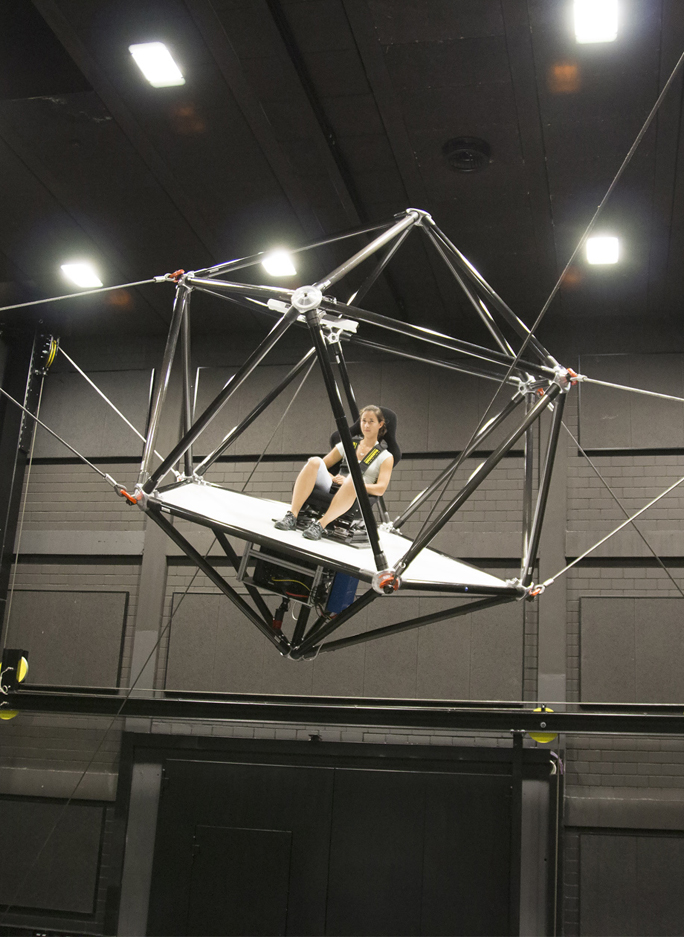
Heinrich Bulthoff
Cable Robot Simulator
Max-Planck-Institut für biologische Kybernetik
Eight steel cables, each with 1.4 tons of tensions, hold aloft a caged platform with a seat for one person. Using a wireless VR headset, that person can simulate experiences like flight while being zoomed in dozens of different ways. Eight retracting cables connected to a winch pull on the cage. It’s like a giant, flying VR jungle gym.
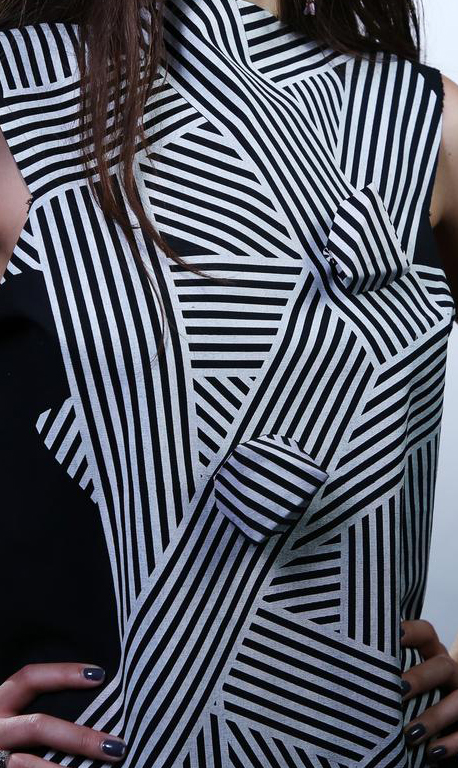
Kino
MIT Media Lab, Stanford University
This work explores a dynamic future where the accessories we wear are no longer static, but are instead mobile, living objects on the body. Engineered with the functionality of 18 robotics, this “living” jewelry roams on unmodified clothing, changing location and reconfiguring appearance according to social context and enabling multitude presentations of self. With the addition of sensor devices, they transition into active devices which can react to environmental conditions. They can also be paired with existing mobile devices to become personalized on-body assistants to help complete tasks. Attached to garments, they generate shape-changing clothing and kinetic pattern designs–creating a new, dynamic fashion.
It is our vision that in the future, these robots will be miniaturized to the extent that they can be seamlessly integrated into existing practices of body ornamentation. With the addition of kinetic capabilities, traditionally static jewelry and accessories will start displaying life-like qualities, learning, shifting, and reconfiguring to the needs and preferences of the wearer, also assisting in fluid presentation of self. We envision a new class of future wearables that possess hybrid qualities of the living and the crafted, creating a new on-body ecology for human-wearable symbiosis.
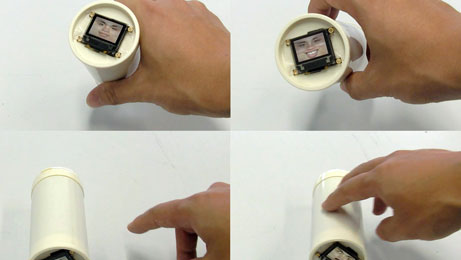
KAZUSHI MUKAIYAMA
IJIROS
file festival
Ijiro is a robot which expresses emotions reacting to a user’s actions. Boldly, it consists of an OLED display, a speaker and an accelerometer in a cylinder shell. Ijiro isn’t able to move itself because it doesn’t have any actuators. However, it expresses emotions with faces in the display and voice from the speaker when a user touches it, lying, standing, swinging, hanging and so on. For example, if a user swings it softly, it reacts smiling. But if a user swings it roughly, it reacts angrily. So those reactions let users feel it like a baby. It is actually baby’s emotions characterized by cognitive science. Also, Ijiro’s shape is designed as a cylinder. It is considered to get various user’s actions because only a cylinder can be stood, lied down, rolled and so on in primitive shapes. Recently it has been easier to use electronic parts for arts. One advantage of making art pieces with compact electronics like a cell phone. So the art style is able to change from being viewed in a large room to being anywhere. Ijiro was developed to entertain people to keep it like a physical pet. We hope you all enjoy touching it.

RAFFAELLO D’ ANDREA AND MAX DEAN
The Robotic Chair
The Robotic Chair is a generic-looking wooden chair with the capacity to fall apart and put itself back together. With shuddering force, the chair collapses to the floor. With persistence and determination, it proceeds to seek out its parts and upright itself. Powered by MICROMO coreless dc motors, The Robotic Chair is distinguished in the world of objects for its capacity to elicit empathy, compassion and hope.

HUANG YI & KUKA
The work fulfills Huang’s childhood dream of having a robot dance partner and required development from scratch. After learning the mechanics of the industrial KUKA robot, he conceptualized the movements and programmed the machine to create the partner he wanted. He says of the experience, “Dancing face to face with a robot is like looking at my own face in a mirror… I think I have found the key to spin human emotions into robots.” It was developed into a full-length piece with two additional dancers as part of 3-Legged Dog Art & Technology Center‘s Artist Residency program and their 3LD/3D+ program.

COD.ACT
Coro pêndulo
Pendulum Choir é uma peça coral original para 9 vozes A Cappella e 18 macacos hidráulicos. O coro é constituindo por um corpo vivo e sonoro. Esse corpo se expressa por meio de vários estados físicos. Sua plasticidade varia de acordo com sua sonoridade. Varia entre sons abstratos, sons repetitivos e sons líricos ou narrativos. Os corpos dos cantores e suas vozes brincam com e contra a gravidade. Eles se tocam e se evitam, criando polifonias vocais sutis. Ou, apoiados por sons eletrônicos, rompem sua coesão e explodem em um voo lírico ou se dobram em um ritual obsessivo e sombrio. O órgão viaja da vida à morte em uma alegoria robótica onde a complexidade tecnológica e o lirismo dos corpos em movimento se combinam em uma obra com acentos prometéicos.
.
Pendulum Choir is an original choral piece for 9 A Cappella voices and 18 hydraulic jacks. The choir is constituted by a living and sonorous body. This body expresses itself through various physical states. Its plasticity varies according to its sound. It varies between abstract sounds, repetitive sounds and lyrical or narrative sounds. The singers’ bodies and their voices play with and against gravity. They touch and avoid each other, creating subtle vocal polyphonies. Or, supported by electronic sounds, they break their cohesion and explode in a lyrical flight or bend in an obsessive and dark ritual. The organ travels from life to death in a robotic allegory where technological complexity and the lyricism of moving bodies combine in a work with Promethean accents.

HUANG YI & KUKA
Ein Duett von Mensch und Roboter
Huangs Pionierarbeit ist geprägt von seiner Faszination für die Partnerschaft zwischen Mensch und Roboter. Kontinuierliche Bewegung verwebt er mit mechanischen und multimedialen Elementen zu einer Tanzform, die mit dem Datenfluss korrespondiert, den Performer zum Tanzinstrument macht.

Sean Follmer, Mac Schwager & Allison Okamura
An untethered isoperimetric soft robot
The simplest version of this squishy robot is an inflated tube that runs through three small machines that pinch it into a triangle shape. One machine holds the two ends of the tube together; the other two drive along the tube, changing the overall shape of the robot by moving its corners. The researchers call it an “isoperimetric robot” because, although the shape changes dramatically, the total length of the edges – and the amount of air inside – remains the same.

Dragan Ilic
Re)Evolution
With the machine programed to draw, the robot becomes a medium for interaction and for “symbiosis” with the artist, creating a kind of “hybrid body” of man and machine, whose nervous system and brain waves administer “software commands” to the robot during the drawing performance. A key actor in the exhibition will be the new model of the KUKA KR 210 robot, that has a multi-functioning performative role: from drawing, experimental dance, music – through the production of industrial sound, and a six channel video projection that documents Ilić’s projects.
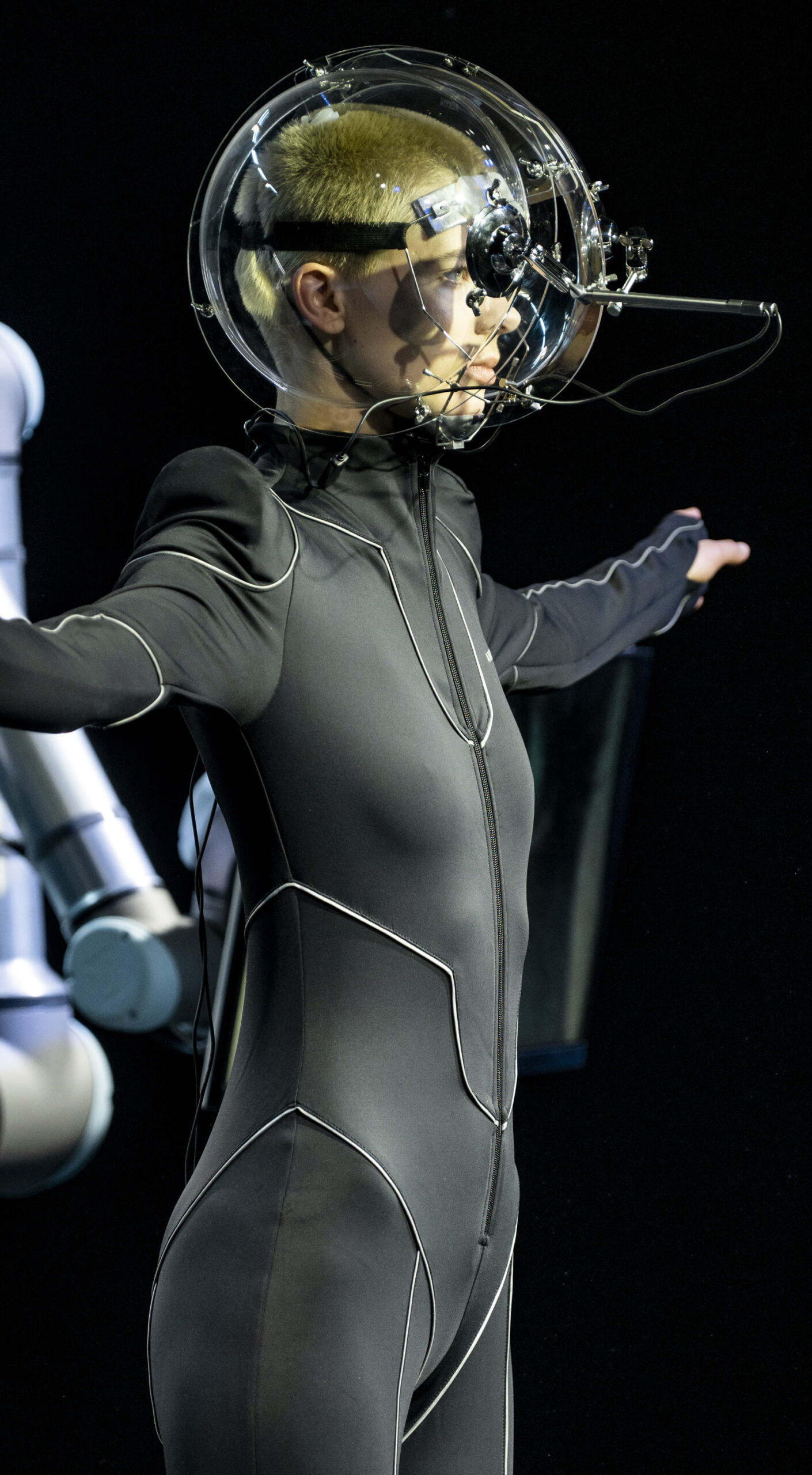
Behnaz Farahi
19Returning the Gaze
‘Returning the Gaze’ is an cyber-physical robotic installation by Behnaz Farahi supported by Universal Robots for ANNAKIKI’s Milan Fashion Week. ‘Returning the Gaze’ is an exploration of this scenario. In the center, a female model wears a spacesuit-like outfit and a headpiece fitted with two tiny cameras. The cameras track and capture the movements of the model’s eyes, and enlarging and displaying them on four monitors mounted moving around on robotic arms glaring back at the observers. The gaze of the model is thereby directed back at the viewer, extended and enhanced through cyborgian technologies.

GUTO NÓBREGA
Breathing
File Festival
Breathing is a work of art based on a hybrid creature made of a living organism and an artificial system. The creature responds to its environment through movement, light and the noise of its mechanical parts. Breathing is the best way to interact with the creature.
This work is the result of an investigation of plants as sensitive agents for the creation of art. The intention was to explore new forms of artistic experience through the dialogue of natural and artificial processes. Breathing is a pre-requisite for life, and is the path that links the observer to the creature.Breathing is a small step towards new art forms in which subtle processes of organic and non-organic life may reveal invisible patterns that interconnect us.Breathing is a work of art driven by biological impulse. Its beauty is neither found isolated on the plant nor in the robotic system itself. It emerges at the very moment in which the observer approaches the creature and their energies are exchanged through the whole system. It is in that moment of joy and fascination, in which we find ourselves in a very strange dialogue, that a life metaphor is created.Breathing is the celebration of that moment.

Jordan Wolfson
요르단 울프슨
ジョーダンウォルフソン
Female Figure
The stare of the animatronic sculpture is so intense, it would put anyone uncomfortable. The mask is probably there as a way to avoid creating a human face using animatronics but it also definitely adds to the creepiness of the overall look. The importance of the gaze is found throughout Wolfson’s work but it finds here a very special interpretation. He gives the ability to gaze to two different entities, a stripper and a robot, who are by definition never supposed to look up. The visitor is no longer in control of the situation, creating the awkwardness that is at the core of the work.
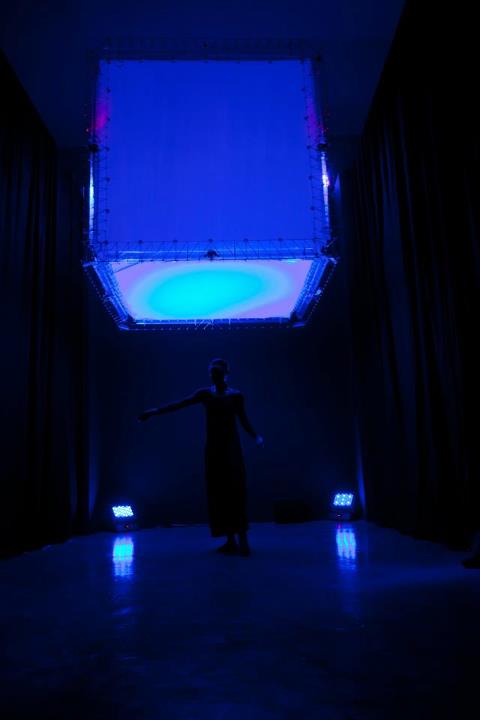
NXI GESTATIO: NICOLAS REEVES, DAVID ST-ONGE & GHISLAINE DOTÉ
Paradoxal Sleep
File Festival
O projeto “Paradoxal Sleep” integra uma série de obras na qual grandes cubos robotizados, medindo 2,25 m3, funcionam como estruturas flutuantes usadas como plataformas para vários projetos multimídia e performances. No FILE 2012, a equipe da NXI GESTATIO apresentará um único cubo que irá se mover nos espaços expositivos. O cubo reajustará constantemente sua posição medindo a distância entre as paredes ao redor.
.
The “Paradoxal Sleep” project integrates a series of works in which large robotic cubes, measuring 2.25 m3, function as floating structures used as platforms for various multimedia projects and performances. At FILE 2012, the NXI GESTATIO team will present a single cube that will move in the exhibition spaces. The cube will constantly readjust its position by measuring the distance between the surrounding walls.

Nix Liu Xin
Three Supermarkets
Three Supermarkets is an infinite loop film with a shopping cart riding across multiple coexisting fictional supermarkets. As the first episode of the Phygital Supermarket Trilogy, this film explores the hybrid compositing of the emerging physical and digital media and techniques. The production process of this film uses industrial-grade six-axis Staubli robot arm as shooting equipment, green screen shooting, volumetric video capture, photogrammetry, Cinema 4D Mograph, Redshift shading & rendering, 2D/3D compositing, and other custom build techniques and workflows. Familiar but neglected objects, such as apples and snack bags, were scanned as either static models or animated model sequences from the physical world to the digital space.
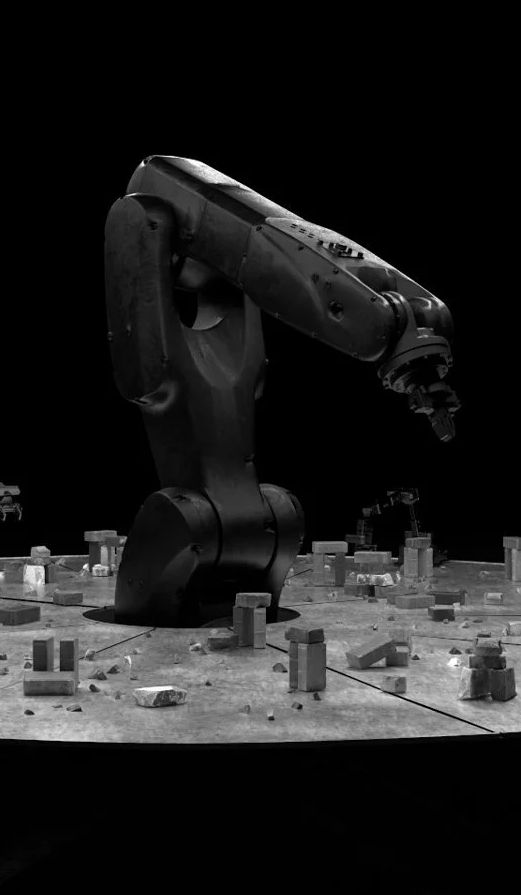
Kachi Chan
Sisyphus
Sisyphus est une installation d’art robotique qui présente deux robots engagés dans un mécanisme cyclique sans fin. Une équipe de petits robots continue de construire des arches en briques tandis qu’un robot géant les pousse vers le bas. Les systèmes robotiques propulsent un récit de construction et de déconstruction.

SOUGWEN CHUNG
Zeichenvorgänge
Sougwen Chung ist eine international bekannte multidisziplinäre Künstlerin, die handgezeichnete und computergenerierte Markierungen verwendet, um die Nähe zwischen der Kommunikation von Person zu Person und der Kommunikation von Person zu Maschine zu untersuchen. Sie ist eine ehemalige Forscherin am MIT Media Lab und derzeit Artist in Resident bei Bell Labs und dem New Museum of Contemporary Art in New York. Ihre spekulative kritische Praxis umfasst Installation, Skulptur, Standbild, Zeichnung und Performance. Drawing Operations Unit: Generation 1 ist die erste Stufe einer laufenden Studie über die Interaktion zwischen Mensch und Roboter als künstlerische Zusammenarbeit.

Bill Vorn
Copacabana Machine Sex
Copacabana Machine Sex is een 30 minuten durende burleske muzikale robotvoorstelling met uitsluitend biomorfe machines als acteurs, muzikanten en dansers. Mijn doel is niet om een echt cabaret na te bootsen, maar om een metaforisch spektakel te bedenken als antwoord op de vraag: “Wat zou er gebeuren als machines op een cabaretpodium zouden staan?” Esthetisch gezien is de set een vreemde hybride mix tussen de klassieke Broadway-kitsch en de donkere industriële look van mijn eerdere werken. Zoals het meeste van mijn werk is het een verkenning van robotachtige vormen en bewegingen door middel van muziek, geluid en licht.
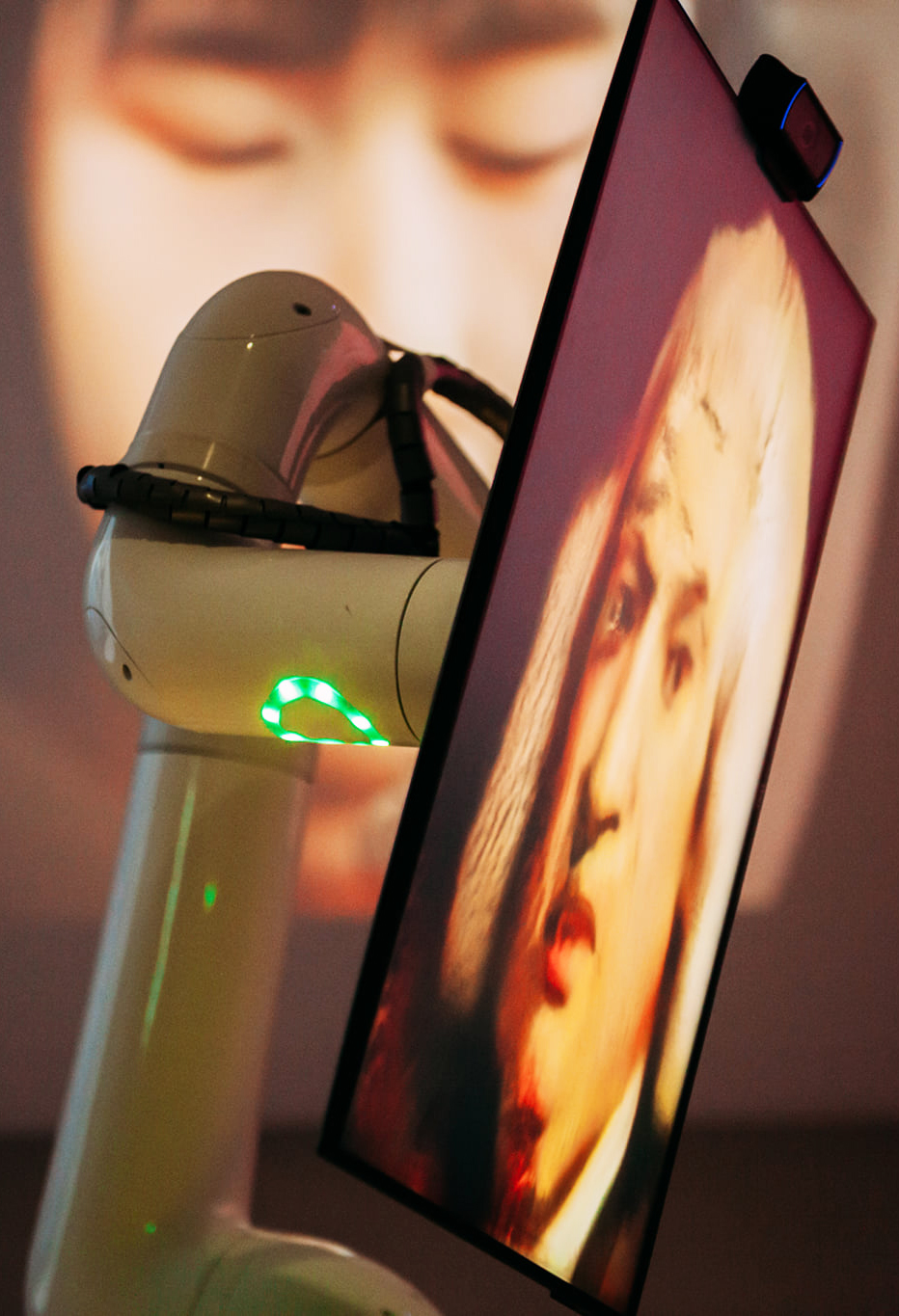
Cho Youngkak
A Hot talks about Something, Someday, Someone
Se basa en Meme (meme / meme; imagen, video), que es un nuevo medio de comunicación que funciona como lenguaje en un sistema de red como Internet. Basados en Meme, las imágenes y los videos reproducidos se reconstruyen recientemente mediante inteligencia artificial y se presentan en una forma que cambia según la interacción de la audiencia. Basado en los datos recibidos a través de la cámara, un algoritmo de inteligencia artificial (StyleGAN: A Style-Based Generator Architecture for GANs) reacciona con cada modelo entrenado y audiovisualmente a través de la visualización y la robótica (robot cooperativo) en el lenguaje reconstruido. Este proyecto se enfoca en crear interacciones basadas en resultados artificiales que no existen en la realidad. El modelo de inteligencia artificial creado proporcionará más experiencias emocionales como sustituto del diálogo humano en lugar de ser aceptado por los humanos en el sentido del meme cotidiano.

Hiroshi Ishiguro
Mindar
Революция машин уже пришла в религию – по крайней мере, в Японии. Буддийский храм в городе Киото решил изменить свои практики, чтобы стать ближе к людям, и установил там робота. Твоя роль? Объявляйте проповеди верующим. Робот Миндар ростом почти шесть футов имеет женский голос и был создан в честь буддийского божества милосердия Каннон. Руки, лицо и плечи корпуса робота покрыты силиконом (имитирующим человеческую кожу). Это все. Все остальное состоит из открытых металлических шестерен.
.
Mindar
A revolução da máquina já entrou na religião – pelo menos no Japão. Um templo budista na cidade de Kyoto decidiu mudar suas práticas para se aproximar das pessoas e instalou ali um robô. Qual é o seu papel? Anuncie sermões aos crentes. Com quase um metro e oitenta de altura, o robô Mindar tem uma voz feminina e foi criado em homenagem à divindade budista da misericórdia Kannon. Os braços, rosto e ombros do corpo do robô são cobertos com silicone (imitando a pele humana). É tudo. Todo o resto consiste em engrenagens de metal expostas.
.
Mindar
The machine revolution has already entered religion – at least in Japan. A Buddhist temple in the city of Kyoto decided to change its practices in order to become closer to people, and installed a robot there. What is your role? Announce sermons to believers. Almost six feet tall, the robot Mindar has a female voice and was created in honor of the Buddhist deity of mercy Kannon. The arms, face and shoulders of the robot body are covered with silicone (imitating human skin). It’s all. Everything else consists of exposed metal gears.
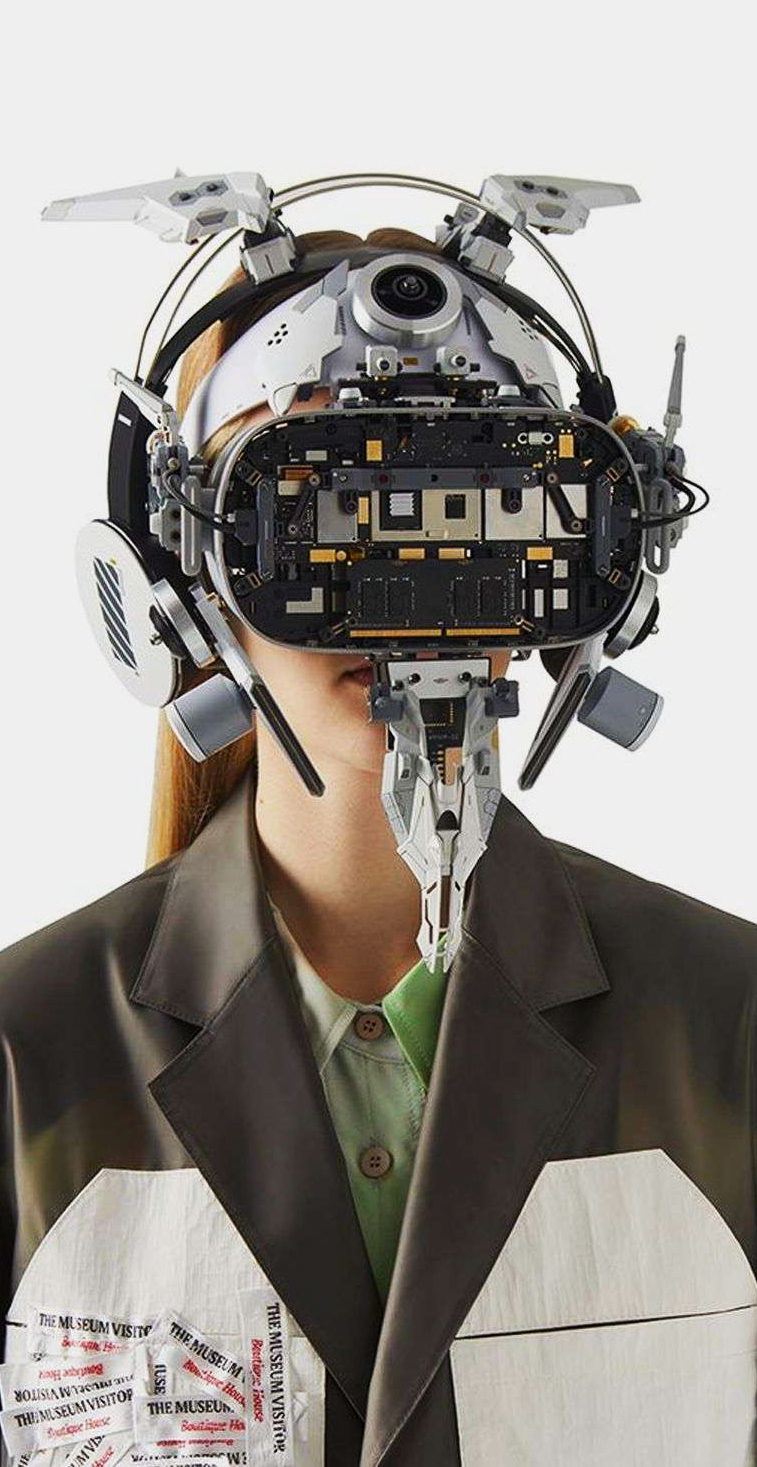
HIROTO IKEUCHI
MPS-15SK “MULTI” EXOSKELETON
Hiroto Ikeuchi kreiert die dystopisch anmutende Version der allseits bekannten Luftkapseln oder der Masken, an die wir uns unbestreitbar gewöhnt haben. Ikeuchi ist ein japanischer Künstler, Designer und Modellbauer mit Sitz in Tokio und weltweit bekannt für seine futuristischen Hightech-Designs, modernen Accessoires und Roboterfiguren, die unser rudimentäres Verständnis von elektronischen oder computergestützten Geräten erschüttern.
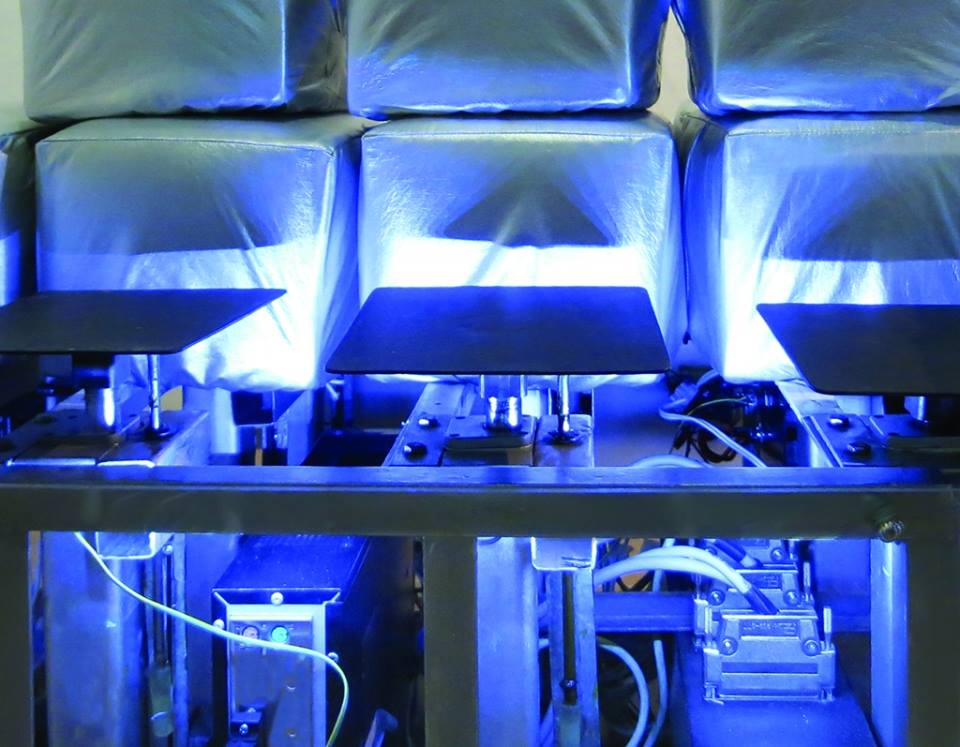
Ricardo Barreto and Maria Hsu Rocha
Martela
FILE Festival
Tactila ist eine Kunstform, deren Medium der Tastsinn (Takt) ist, der von allen anderen unabhängig ist und seine eigene Intelligenz, Vorstellungskraft, Erinnerung, Wahrnehmung und Empfindung hat. Es ist bekannt, dass Bild und Ton in der Kunst und in anderen Disziplinen Vorrang haben. Tactila findet rechtzeitig statt und kann daher aufgezeichnet werden und für spätere Ausführungen verschiedene Notationsformen haben. Deshalb wurde seine Entwicklung dank mechatronischer und Robotersysteme, die mit Maschinensprachen kompatibel sind, erst jetzt möglich. Bei der Erstellung taktiler Werke handelt es sich um eine (Takt-) Komposition, die in handgemachter Notation erstellt und auf einer Tastatur oder direkt darauf gespielt werden kann der Computer der taktilen Maschine (Roboter).
Taktile Maschinen können durch Punkte, Vektoren und Texturen mit unterschiedlichen Rhythmen und Intensitäten zahlreiche taktile Möglichkeiten bieten und an verschiedenen Ausdehnungen und Orten unseres Körpers ausgeführt werden.
Die erste taktile Maschine heißt „Martela“. Es ist ein taktiler Roboter, der aus 27 Motoren besteht, die in drei Quadrate (3 × 3) unterteilt sind, d. H. Jedes Quadrat hat 9 Motoren. Jeder Motor entspricht einem Matrixpunkt, daher haben wir 27 taktile Einheiten, mit denen der Körper des Benutzers mit verschiedenen Intensitäten berührt werden kann.

SUNG ROK CHOI
Great Chain of Being
FILE FESTIVAL
The great chain of being, an ancient philosophical concept, attempted to explain the structures and relationships of the world as a form of hierarchy or set of strata. This philosophical idea is here expressed in the form of the entities that constitute the contemporary world. The philosophers of the past believed that the structure of the world had at its top a god, and that beneath there were angels, animals, plants, and elements. But this conception of the world, as a result of the changes in civilization and culture, resulted in the elements that constitute the world undergoing a transition and sustaining an unforeseen hierarchy. The works of art depict the contemporary structure in the form of robots, machines, people, animals, and virtual or digital entities. Within virtual systems, these entities undergo a process of creation, arrangement, use, disposal and recycling, through which they emerge and disappear. The work depicts the stories emerging from these processes, against the background of a systemically designed landscape akin to a factory.
video

Engineered Arts
AMECA
“Multiply the power of artificial Intelligence with an artificial body. Ameca is the physical presence that brings your code to life. The most advanced lifelike humanoid you can use to develop and show off your greatest machine learning interactions. This robot is the digital interface to the real world.” Engineered Arts
.
“A U.K. robotics firm called Engineered Arts just debuted the first videos of its new humanoid robot, which is able to make hyper-realistic facial expressions. It’s a pretty stunning achievement in the world of robotics; it just also happens to be absolutely terrifying.
Named Ameca, the robot’s face features eyes, cheeks, a mouth, and forehead that contort and change shape to show off emotions ranging from awe to surprise to happiness. One of the new videos of Ameca shows it waking up and seemingly coming to grips with its own existence for the first time ever.” Neel V.Patel

Sougwen Chung
愫君
Drawing Operations
Sougwen Chung is an internationally renowned multidisciplinary artist, who uses hand-draw and computer-generated marks to address the closeness between person-to-person and person-to- machine communication. She is a former researcher at MIT Media Lab and current Artist in Resident at Bell Labs and New Museum of Contemporary Art in New York. Her speculative critical practice spans installation, sculpture, still image, drawing, and performance. Drawing Operations Unit: Generation 1 is the 1st stage of an ongoing study of human and robotic interaction as an artistic collaboration.

Skylar Tibbits
Aerial Assemblies
Self-Assembly is a process by which disordered parts build an ordered structure through local interaction. We have demonstrated that this phenomenon is scale-independent and can be utilized for self-constructing and manufacturing systems at nearly every scale. We have also identified the key ingredients for self-assembly as a simple set of responsive building blocks, energy and interactions that can be designed within nearly every material and machining process available. Self-assembly promises to enable breakthroughs across every applications of biology, material science, software, robotics, manufacturing, transportation, infrastructure, construction, the arts, and even space exploration.

Bill Vorn & Louis-Philippe Demers
루이 필립 멀스
Луи-Филипп Демерс
Inferno
“Inferno” est un projet de performance robotique inspiré par la représentation des différents “niveaux de l’enfer”, la particularité de ce projet réside dans le fait que les différentes machines faisant partie du spectacle seront installées sur le corps même des spectateurs.

Playmodes Studio
“Espills” is a solid light dynamic sculpture. Built using laser beams, laser scanners and robotic mirrors, it is inspired by crystalline formations. A set of geometric figures that float in the air and which suggest, in an abstract way, the transmutation of matter from chaos to order. Dust becoming crystal, being eroded and becoming sand again.
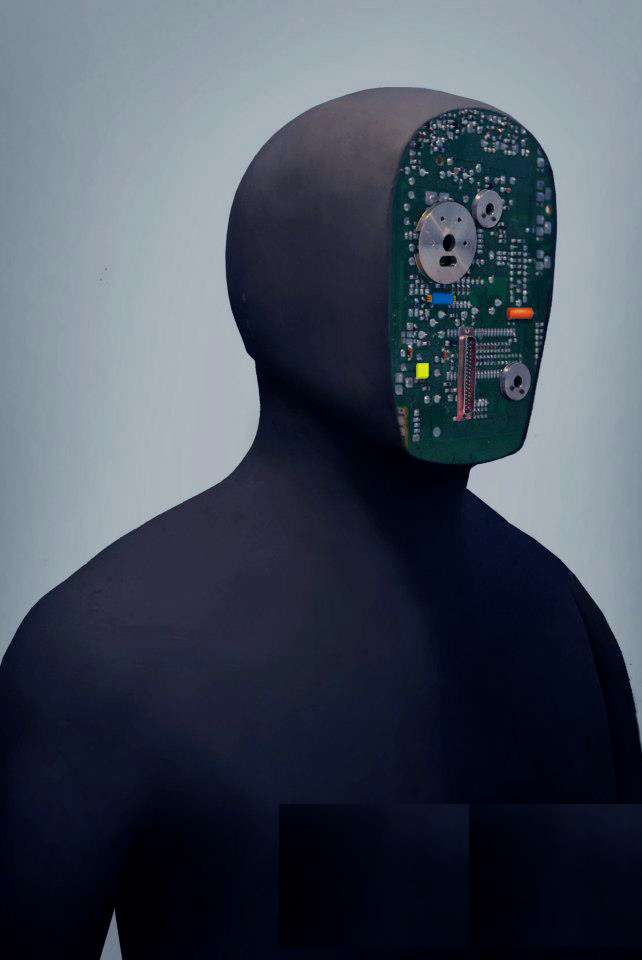
Daft Punk
Electroma
DAFT PUNK’S ELECTROMA IS THE EAGERLY ANTICIPATED DIRECTORIAL FEATURE FILM DEBUT FROM GUY-MANUEL DE HOMEM-CHRISTO AND THOMAS BANGALTER, BETTER KNOWN TOGETHER AS DAFT PUNK. A PSYCHEDELIC VISUAL AND MUSICAL ODYSSEY, ELECTROMA FOLLOWS THE JOURNEY OF TWO ROBOTS ON THEIR QUEST TO BECOME HUMAN. FEATURING A STUNNING SOUNDTRACK WITH MUSIC FROM TODD RUNDGREN, BRIAN ENO, CURTIS MAYFAIR, SEBASTIEN TELLIER AND CHOPIN, ELECTROMA PLAYS OUT BEAUTIFULLY ‘LIKE MUSIC FOR THE EYES’.

Leonhard Lass & Gregor Ladenhauf
Der Eidolon spaltet sich
Der Eidolon spaltet sich untersucht die Konstruktion menschlicher Form und Identität in einem narrativen Bereich. Es reflektiert und verkörpert den Bildschirm als Portal und Kontaktfläche sowohl als physisches als auch als virtuelles Gerät.

PATRICK TRESSET
Étude humaine #1
L’installation interactive Human Study #1 de Patrick Tresset se compose de trois robots dessinateurs. Les visiteurs peuvent s’asseoir comme des modèles pour être visuellement enregistrés et représentés par les trois machines. Chacun des trois robots dessine dans son propre style et manie le stylo d’une manière différente. A côté du bras de dessin, chaque robot est équipé d’une caméra mobile. Ils les utilisent pour observer alternativement le modèle et le dessin résultant. Tresset n’est pas intéressé à utiliser les robots pour simuler un style de dessin humain. Il examine plutôt les différences entre l’exécution humaine et robotique. Tresset décrit les capacités de ses machines comme « non intelligentes ». Ils donnent seulement l’impression d’agir de leur propre gré. Ils font preuve d’un comportement humain, mais basé sur un programme ne stipulant qu’un ensemble restreint d’actions.

PETER WILLIAM HOLDEN
SoleNoid
Otto scarpe da tip tap sono disposte in uno schema circolare simmetrico. Queste scarpe sono a loro volta fissate a semplici strutture robotiche che utilizzano attuatori pneumatici ed elettrovalvole. Ciò consente alle scarpe di muoversi in molti modi. Ogni diverso movimento genera un tono diverso e questi suoni vengono sequenziati per produrre una performance uditiva.

Aidan Meller
AI-DA
Ai-Da est le premier artiste ultra-réaliste au monde. Elle dessine en utilisant des caméras dans ses yeux, ses algorithmes d’IA et son bras robotique. Créée en février 2019, elle a eu sa première exposition solo à l’Université d’Oxford, « Unsecured Futures », où son art a encouragé les téléspectateurs à réfléchir à notre monde en évolution rapide. Depuis, elle a voyagé et exposé des œuvres à l’échelle internationale, et a eu sa première exposition dans un grand musée, le Design Museum, en 2021. Elle continue de créer de l’art qui remet en question nos notions de créativité dans une ère post-humaniste.

SUN YUAN AND PENG YU
Non posso fare a meno di me stesso
Costruito con un braccio robotico industriale Kuka, “Can’t Help Myself” è programmato per fare una cosa: contenere un liquido viscoso di colore rosso intenso all’interno di un’area fissa. Quando la sostanza simile al sangue si accumula troppo, questo attiva i sensori del robot facendo ruotare, flettere e spostare il liquido al centro, lasciando dietro di sé schizzi e macchie.
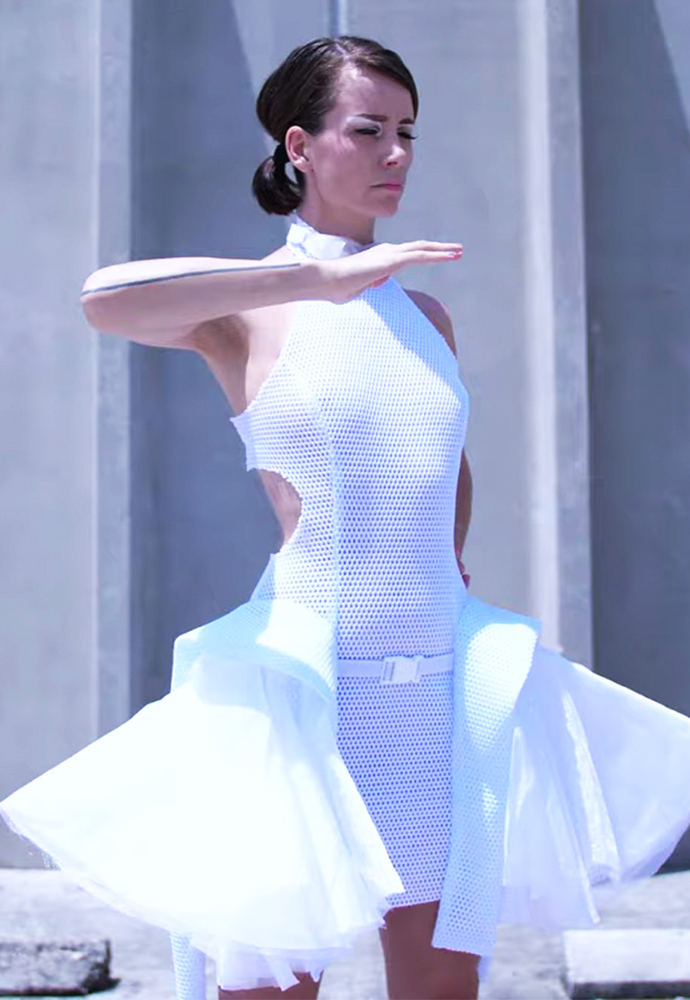
ANOUK WIPPRECHT
Nabijheidsjurk
Door mijn onderzoek naar proxemics en het lichaam uit te breiden, heb ik twee nieuwe jurken gefabriceerd die fysieke barrières creëren wanneer een persoon wordt gedetecteerd in de directe omgeving van de drager. Deze tweelingjurken reageren op basis van nabijheids- en thermische sensoren en duiden vreemden aan in de intieme, persoonlijke, sociale en openbare ruimte rondom de drager. Elke jurk breidt zichzelf uit met behulp van een robot 3D-geprint heupmechanisme ingebouwd in de jurk en een hars 3D-geprinte transparante kraag met de sensoren.

Moritz Simon
Glitch Robot
The Installation consists of several robotic actors. When the actors make contact with their instruments, they produce a sonic impression of an omnipresent texture of modern life: electronic music. The music robots used in this performance consists of recycled and 3D-printed parts such as harddisks, relays, tongues, motors and solenoids. Glitch Robot connects mechanical, visible movements to audible sound by using small sound-producing robots. Thus, the installation highlights the origin of the sound in a way no conventional medium of electronic music production is able to. Typically, electronic music eliminates the haptic aspect of sound-generation, creating a void in understanding of how sound, and thus music, is mechanically created.

Jason Bruges Studio
The Constant Gardeners
S’inspirant d’un jardin zen japonais traditionnel, quatre bras de robots industriels sont disposés autour d’une vaste toile de gravier avant de se réveiller et de commencer à ratisser la surface. Dans une série de performances quotidiennes, ces « jardiniers » travaillent ensemble pour créer des illustrations uniques et évolutives représentant les mouvements des athlètes. Générées par une série d’algorithmes sur mesure, qui analysent des séquences vidéo d’événements olympiques et paralympiques, certaines illustrations représentent un mouvement qui se déroule dans le temps tandis que d’autres mettent en lumière un moment sportif spectaculaire. Une méditation sur la tradition, l’artisanat et les rôles de la technologie, The Constant Gardeners offre aux visiteurs un espace paisible pour une introspection tranquille. L’œuvre explore un nouveau récit autour de la robotique, montrant que cette technologie est une force capable de créativité artistique et d’action expérimentale, qui joue un rôle déterminant dans notre cheminement vers un avenir plus heureux et plus sain.

Martin Backes
Music Automats
“Music Automats é uma instalação de som robótica autônoma. A peça é composta por diversos instrumentos robóticos, construídos a partir de instrumentos acústicos, objetos do cotidiano, motores, componentes eletrônicos, peças de madeira e metal. LEDs nos instrumentos visualizam o som. O resultado é um mundo de som futurista totalmente automatizado que também é visualmente único devido aos instrumentos e robôs construídos por nós mesmos. A obra explora a coevolução do homem e da máquina, um futuro em que já nos encontramos.” Martin Backes

BILL VORN
Copacabana Machine Sex
Copacabana Machine Sex es una actuación de robot musical burlesco de 30 minutos que presenta solo máquinas biomórficas como actores, músicos y bailarines. Mi objetivo no es imitar un cabaret real, sino idear un espectáculo metafórico en respuesta a la pregunta: “¿Qué pasaría si las máquinas estuvieran en un escenario de cabaret?” Estéticamente, el decorado es una extraña mezcla híbrida entre el clásico kitsch de Broadway y el oscuro aspecto industrial de mis trabajos anteriores. Como la mayoría de mi trabajo, es una exploración de formas robóticas y movimiento a través de la música, el sonido y la luz.

Hiroshi Ishiguro Lab and Dr Dylan Glass
Erica
ERICA EST DÉVELOPPÉ POUR UNE PLATEFORME DE RECHERCHE POUR LE ROBOT CONVERSATIONNEL AUTONOME QUI PEUT COMMUNIQUER AVEC LES PERSONNES DE DIVERSES FAÇONS TELLES QUE LA VOIX, LES GESTES CORPORELS, LES EXPRESSIONS FACIALES, LE CONTACT VISUEL ET LE TOUCHER. L’APPARENCE D’ERICA EST FAITE EN CG CONÇU POUR AVOIR LES CARACTÉRISTIQUES QUE LES BEAUX VISAGES ONT. LA VOIX EST GÉNÉRÉE PAR LA TECHNOLOGIE TEXTE-PAROLE DE LA PLUS HAUTE QUALITÉ. LES ACTIONNEURS PNEUMATIQUES DÉPLACENT SON CORPS DOUCEMENT AVEC UN PETIT BRUIT SEULEMENT. L’OBJECTIF DE L’ÉTUDE EST DE CRÉER DES ANDRODES CONVERSATIONNELS AUTONOMES QUI PEUVENT INTERAGIR NATURELLEMENT AVEC LES GENS ET S’IMPLIQUER SOCIALEMENT DANS LA VIE QUOTIDIENNE.
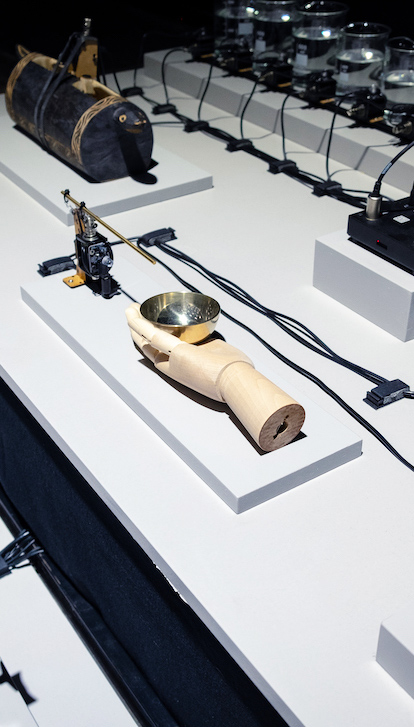
Martin Backes
Music Automats
‘Music Automats’ est une installation sonore robotique autonome. La pièce est composée de plusieurs instruments robotiques, construits à partir d’instruments acoustiques, d’objets du quotidien, de moteurs, de composants électroniques, de pièces en bois et en métal. Des LED sur les instruments visualisent le son. Le résultat est un monde sonore futuriste entièrement automatisé qui est également visuellement unique en raison des instruments et des robots auto-construits. L’œuvre explore la co-évolution de l’homme et de la machine, un avenir dans lequel nous nous trouvons déjà.

